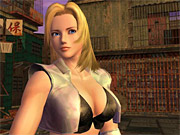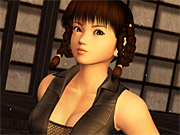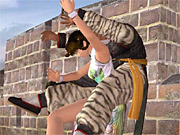Though Dead or Alive is nearly 10 years old, the 3D fighting game series has never quite managed to steal the limelight from its direct competitors, namely Virtua Fighter, Tekken, and Soul Calibur. That is...not until now. Dead or Alive Ultimate features the series' signature characters and gameplay, which strikes a good balance between offering flashy pick-up-and-play appeal and delivering the long-term depth that fighting game fans want. Furthermore, it sports the most fully featured online multiplayer mode of any fighting game yet, which is a huge accomplishment. This multiplayer mode presents some innovative twists that admirably attempt to restore the spirit of arcade competition, where the fighting game genre was born and thrived. With that said, the core gameplay in Dead or Alive Ultimate really hasn't changed much since the release of Dead or Alive 2 about five years ago, so if you've played any of the recent installments in the series, you'll know exactly what to expect here. But thanks to a beautiful new coat of paint--not to mention the online play--the series' time-tested formula seems better than ever now.

Dead or Alive Ultimate actually consists of two different 3D fighting games: "Ultimate" versions of the original Dead or Alive and its vastly superior sequel, which made quite a splash on the Dreamcast and the PlayStation 2 in 2000. Both games offer similar online play features but otherwise basically stay true to their roots. The package's "Ultimate" version of Dead or Alive 2 is the obvious highlight, featuring vastly improved visuals over its previous incarnations and much more sophisticated gameplay than the first Dead or Alive game. Collectively, these things make the older Dead or Alive title (which is inexplicably included on a separate disc) look merely like some kind of throwaway extra. It's a relatively ugly, simplistic game, but if you're nostalgic for Dead or Alive, you'll appreciate its inclusion. The Xbox's own Dead or Alive 3 is noticeably absent from DOAU, but it's really no loss--Hitomi, the most popular of that game's three additional characters, is unlockable in DOA2 Ultimate, and DOA3 didn't do much more than include these few extra characters and spruced-up graphics.
Would even more characters and more moves have benefited DOA2 Ultimate? No, not really. The fact that proper balance has apparently been achieved among the game's roster of 15 characters (three of whom are initially hidden) is important, because competitive online play means any issues with balance would quickly be exploited. Furthermore, the relatively simple play mechanics and consistently fast-paced feel of the action means that the different characters in DOA2 Ultimate really don't play that differently, so it's easy to switch from playing one character to then play another. Each character has literally dozens of his or her own unique moves, but the vast majority of all these require very simple combinations of buttons and D pad commands. A few moves require simultaneous button presses or Street Fighter II-style circular motions, but these are the exceptions. The game's depth certainly doesn't come from mastering how to execute all the different moves; instead, it comes from knowing when and where to use them.

Dead or Alive has always had two specific features that distinguished the series: One is the fantastical proportions of the game's female characters, and two is every single character's ability to reverse just about any punch or kick your opponent can muster. These features are fully intact in DOAU, especially in the better of the two games. Reversals add an additional dimension of rock-paper-scissors-style balancing to the proceedings. It works like this: Characters can execute high-, mid-, and low-hitting attacks, which must be blocked high or low--or, better yet, reversed. A reversal deals damage proportional to the strength of the attack on the receiving end, so those who predictably rely on the same strong punches or kicks over and over are basically just asking for a major beating. Missed reversals leave you open to counterattack, of course, and getting thrown while attempting a reversal causes you to take more damage than usual. On the other hand, throw attempts are easily disrupted by punches or kicks. None of this is quite as complicated as it sounds, however. Basically, the idea is to remain unpredictable by mixing up your offense and defense.
The action plays out extremely quickly, often to the extent that strategy and forethought often take a backseat to purely reflexive intuition. Translation: In Dead or Alive, things happen fast, and it's not uncommon for beginners to handily defeat far more experienced players simply by using naturally unpredictable patterns of reckless punches and kicks. Of course, keeping a cool head and a steady hand pays off over time, especially if you can learn to quickly read an opponent and then counter his or her moves. One thing's for sure about DOAU's gameplay: It completely favors the aggressor, since even on defense, you really should be going for reversals instead of just blocking. Extradamaging counter hits happen frequently and often occur unintentionally. As such, rounds of combat (and therefore the default best-of-three-round matches) can be resolved in mere matters of seconds. Consequently, those who prefer a more methodical pacing to their fighting games might not appreciate DOAU's extremely quick pacing, though the simple controls and impressive-looking moves make this a good fighting game for beginners. Again, though, there's some real depth here, and it quickly becomes evident when playing against a highly skilled opponent.

You won't find much of an opponent in the game's artificial intelligence, unfortunately. The AI does make for a respectable challenge in the short run, and playing against it is the key to unlocking much of the game's ample supply of unlockable costumes and other extras. However, the AI is rather predictable despite being fairly tough at higher difficulty levels, at which it'll mostly just reverse your moves with greater frequency. So, blazing through the story mode is really a cinch, at which time you might miss your character's ending if you so much as blink. The story mode really hasn't changed at all after all these years, and though it lets you quickly practice against a bunch of the game's characters (matches are only one round in story mode), it's just not that great. Fortunately, there are numerous other gameplay modes available, including a fast-paced survival mode in which additional challengers keep jumping into the arena one after another, as well as tag battles in which you can quickly switch between a pair of characters who can sometimes band together for some superpowered combos and special throws. Of course, there's an offline versus mode, too. However, online is where Dead or Alive Ultimate has the most potential--and tons of it.
In addition to the standard Xbox Live quick match and optimatch options, the game gives you a lot more flexibility when creating (or searching for) a match than you might expect. The main innovation here is a lobby system that allows up to eight players to congregate in a single "virtual arcade." Imagine this online chat room as a metaphor for up to eight friends and/or strangers hanging around an arcade cabinet in the '90s. Basically, two players still duke it out one match at a time, although everyone else can observe the match, mess with the camera perspective while waiting for his or her turn, and discuss the finer points of the fight (via voice chat) as it wears on. The voice communication is never interrupted as matches begin and end, nor is there really any noticeable loading time at any point in the game (even, say, if players pick four different characters in a tag team match), so the social dynamic of DOAU's lobby system seems to be very well integrated. It begs the question, though, of why you'd deliberately want to wait to play between matches. The answer is that, in general, you probably wouldn't want to do so. So if you prefer a traditionally "home-style," uninterrupted one-on-one fighting-game experience, DOAU lets you set one up by limiting your player lobby to two players when creating a match. The two of you can then keep playing as much as you'd like.

What's most important is that the action is pretty much just as fast and responsive online as it is offline. Occasional hiccups of lag were far from customary and were never really detrimental to gameplay during our testing, in which we experienced smooth offline-quality action even when playing over a standard DSL connection.
Like any fighting game, DOAU is going to be more fun if you can play it against opponents of similar skill level, and to that end, the game's online play seems to provide exactly the right context for all the competition you'd ever want. The game automatically gives you a letter grade based on your ongoing track record (you start out with a "C" and move up or down from there), and it optionally allows you to search for opponents within your preferred grade range, further increasing the likelihood that you'll experience a good, even fight. Furthermore, the communal atmosphere of the game's lobby system theoretically means more players will maintain proper etiquette; if players goof off or otherwise act inappropriately...there will be witnesses.
Online, DOAU offers a variety of different modes, some of which are pretty surprising. Most all the offline variants are available, including tiered tournaments and team battles, but there are a few other twists here. The standard match type is an arcade-style "winner stays" series in which the winner of each match continues taking on challengers. There's a bizarre "loser stays" alternative, ostensibly for the benefit of those players content with continual defeat and for those philanthropic opponents willing to indulge them. There's another variant in which the winner of each match becomes the lobby's "champion," which means that player is free to then change the rules of the game, such as by increasing or decreasing the number of rounds in a match. Before you get in to a lobby, there's even an option to search for DOA1 Ultimate matches (as opposed to DOA2 Ultimate matches), and you can play in these matches with the DOA2 Ultimate disc inserted. However, you just can't create DOA1 Ultimate matches without the DOA1 Ultimate disc in the drive.
Overall, there's just a ton of different online options here, and these options all contribute to making the experience of playing DOAU over Xbox Live as social and competitive as possible. Elaborate rankings are tracked for each individual. In fact, rankings are tracked to the point where you can even see how well you've fared against any single opponent you've ever fought against. Global stats for the game's different characters also help to keep things honest, and a variety of different leaderboards help give a real incentive to take online play seriously. There have been a handful of other fighting games to feature online play, but none thus far have apparently invested so much effort in the online experience as DOAU. If nothing else, the game represents an important step in the evolution of the fighting game genre.

For good measure, DOAU looks absolutely superb. DOA3, an Xbox launch title, really showcased the power of the Xbox right out of the gate, and DOAU continues that tradition. Its visuals are on par with those of this year's outstanding Ninja Gaiden, and, in fact, those familiar with DOA know that the star of that game has been featured in the DOA series all along. Good old Ryu Hayabusa is depicted here exactly as he appears in developer Team Ninja's last game, and the other characters look every bit as detailed and impressive, with clearly articulated hands and detailed facial expressions, as well as clothing that really looks like it's made of real fabric--from leather to denim to latex. The various realistic-looking, motion-captured attacks in the game also mostly yield solid, rather painful-looking results. Moreover, each character has multiple outfits, of which there are literally many dozens to be found in the game. Still, the anime-inspired character designs won't fit every taste, and despite the obviously high level of detail on display in them, it bears mentioning that they look more like action figures than real people.
The backgrounds in the game are absolutely phenomenal, by any measure. Featuring multiple levels and breakable bits (walls, floors, pillars, and so on) that explode spectacularly when a character is shoved into them, the stages in DOAU are incredibly diverse in their appearances, filled with impressive special effects, and loaded with tactical nuance. (However, the more complex stages are not available for use with the game's tag team modes.) All this looks even better when you run it in progressive scan mode on a display that supports higher resolutions. And despite all the rich graphical quality, DOAU mostly maintains a silky smooth frame rate that falters only slightly when there's a quick camera pan at the beginning of a match. Incidentally, this package's version of DOA1 lacks all the graphical improvements showcased in this package's version of DOA2. When compared directly, the games demonstrate the incredible leaps and bounds that video game graphics have made in less than 10 years.

The audio in DOAU is good, but it doesn't live up to the game's visuals. As if out of spite, the game lacks the option for English voice-over, even though Dead or Alive 2: Hardcore featured an English-language track roughly on par with the original Japanese. You don't need to know Japanese to be able to tell that the voice acting here isn't exactly of stupendous quality, and neither is the game's forgettable but suitably fast-tempo soundtrack. The various effects for punches and kicks hitting home also aren't particularly remarkable, but they're solid. Probably the most unique aspect of DOAU's audio is that the surprisingly long and overwrought intro to the game's version of DOA2 is set to Aerosmith's "Dream On".
For a game that's so bold as to call itself "Ultimate," DOAU sure comes close. It truly is the best, most fully featured title in the Dead or Alive series yet. In addition, it's a landmark achievement in the fighting game genre's history-in-the-making, thanks mostly to DOAU's impressive online play component and thanks partly to the game's incomparably good visuals. The fact that the Dead or Alive gameplay formula holds up this well after all these years also speaks volumes, because those who might have mistaken the game's slight learning curve for a lack of complexity in the past will surely see things differently this time...from the moment they happily first get trounced online.